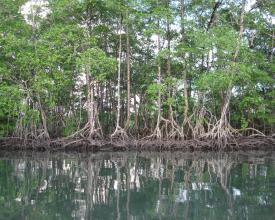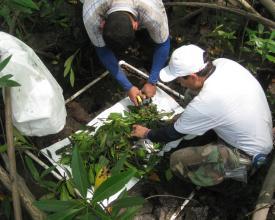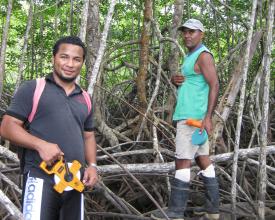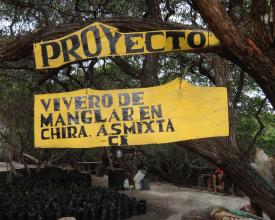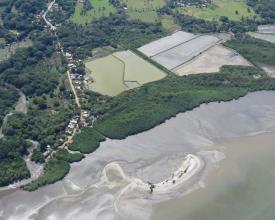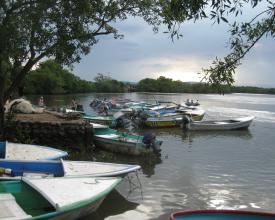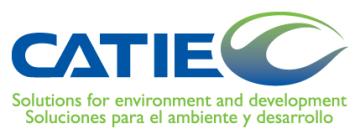
Carbone bleu de A à Z : des petits projets à l'élaboration de politiques
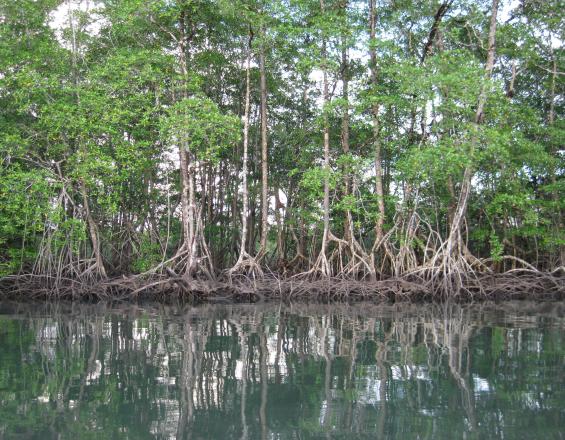
Le carbone bleu est encore un concept nouveau qui a besoin d'une facilitation adéquate pour lancer des projets et promouvoir des actions en faveur du carbone bleu. CATIE entreprend des démarches pertinentes pour faciliter le développement de cadres scientifiques et politiques solides : inventaires des stocks de carbone, études des moyens de subsistance et de la vulnérabilité, évaluation de la dynamique de l'utilisation des terres et des émissions historiques associées, facilitation de l'élaboration de politiques et promotion des capacités dans toute la région d'Amérique centrale et latine.
Contexte
Défis à relever
Des connaissances et des orientations limitées pour la conception et la mise en œuvre de projets liés au carbone bleu. Malgré l'intérêt croissant pour le carbone bleu, les développeurs de projets et les pays disposent de peu de conseils pour concevoir et mettre en œuvre des initiatives qui peuvent offrir des avantages en matière d'atténuation du changement climatique et d'adaptation, tout en améliorant les moyens de subsistance des communautés côtières. CATIE répond à ces besoins grâce à un ensemble cohérent de recherches scientifiques et de conseils politiques dans toutes les Amériques.
Emplacement
Traiter
Résumé du processus
Les éléments constitutifs peuvent fonctionner de concert à l'échelle locale et nationale. Les inventaires locaux de carbone (bloc 1) et la modélisation géospatiale (bloc 3), ainsi que les évaluations des moyens de subsistance et de la vulnérabilité (bloc 2), fournissent des informations permettant d'établir des priorités dans la sélection des sites et d'éclairer la prise de décision au niveau national. Les populations locales et les techniciens gouvernementaux peuvent être recrutés et formés afin de renforcer leurs capacités et d'étendre leurs expériences. Au niveau national, le développement de cadres politiques nationaux (bloc 5) permet d'inclure des éléments de carbone bleu dans la comptabilité et la budgétisation des émissions nationales, les plans d'atténuation et d'adaptation, les stratégies de restauration, les inventaires forestiers nationaux, la REDD+ et le MRV. En outre, les données d'évaluation économique (bloc 4) sont nécessaires pour concevoir des mécanismes financiers qui permettront d'éventuels transferts de fonds afin de promouvoir la conservation locale et d'améliorer le développement local. En outre, l'intégration de ces éléments dans les Amériques vise à promouvoir un réseau régional de scientifiques et de praticiens du carbone bleu, des politiques et des projets qui intègrent les objectifs d'atténuation et d'adaptation tout en promouvant le développement local (élément de base 6).
Blocs de construction
Inventaires de carbone dans les écosystèmes de mangrove
Facteurs favorables
Leçon apprise
Ressources
Évaluation de la vulnérabilité sociale et écologique
Facteurs favorables
Leçon apprise
Modélisation géospatiale et des émissions
Facteurs favorables
Leçon apprise
Évaluation des services écosystémiques
La quantification de la valeur des services écosystémiques fournis par les mangroves aux communautés locales est une composante nécessaire des projets de carbone bleu. Elle sert de base à la conception des systèmes de paiement pour les services écosystémiques (PSE). Une évaluation complète étant difficile et coûteuse, les services prioritaires sont choisis dans le cadre d'un processus de consultation participatif avec les communautés locales. Les données brutes sont collectées localement et exploitées par le biais de recherches bibliographiques et d'entretiens. Les résultats soulignent l'importance des écosystèmes côtiers et marins pour les décideurs, car les pertes de mangroves peuvent être expliquées comme des pertes de capital.
Facteurs favorables
La disponibilité de données locales et nationales est un facteur déterminant pour une évaluation adéquate des services écosystémiques. Même si ces données ne sont pas disponibles, les relations avec les responsables locaux peuvent fournir des critères et des contributions d'experts utiles. De même, la participation des communautés aux diagnostics visant à identifier puis à quantifier les services prioritaires est importante pour garantir leur adhésion au processus. Une bonne compréhension des moyens de subsistance locaux est également nécessaire.
Leçon apprise
La perception locale de ce qui constitue un service écosystémique "prioritaire" pour l'évaluation peut différer de celle des développeurs de projets et des chercheurs. En outre, les contraintes liées aux données peuvent limiter l'étendue de l'étude d'évaluation. Il peut donc s'avérer nécessaire de négocier avec les populations locales, au cours de la phase de diagnostic préliminaire, les services qui répondent à leurs besoins et à ceux du projet, et qui peuvent être évalués. Le large éventail de services fournis par les mangroves et les écosystèmes côtiers et marins environnants rend un exercice d'évaluation complet très difficile. C'est pourquoi la plupart des études d'évaluation sont partielles et dépendent d'un ensemble d'hypothèses et d'une variété de méthodes différentes. De bonnes relations de travail avec les représentants du gouvernement chargés du traitement et de l'archivage des données, ainsi qu'une solide compréhension des détails des moyens de subsistance et des modèles d'entreprise locaux sont très avantageuses, c'est pourquoi une étude des moyens de subsistance doit être menée en parallèle.
Élaboration de cadres politiques nationaux
L'existence de cadres politiques solides facilite la conception et la mise en œuvre d'initiatives locales et nationales en matière de carbone bleu. Ces politiques favorisent le soutien officiel du gouvernement et le fondement des rôles institutionnels, et offrent des liens avec d'autres politiques, mécanismes et stratégies nationaux et internationaux (tels que les CDN, REDD+ et NAMA). Le processus d'élaboration des politiques commence par des consultations informelles avec les autorités nationales afin de recenser les acteurs, d'évaluer leur intérêt et d'obtenir leur soutien. Comme il s'agit de constructions à l'échelle nationale, il est important de fournir des conseils stratégiques et de faciliter le processus.
Facteurs favorables
Il est primordial de susciter l'intérêt et le soutien des autorités nationales occupant des postes de décision, car l'élaboration des politiques est un rôle du gouvernement et ne doit pas être imposée à un pays. L'existence d'autres politiques environnementales, côtières-marines ou relatives au changement climatique permet d'aligner ou d'incorporer les notions de politique du carbone bleu dans les politiques préexistantes. La disponibilité et la communication de données scientifiques fiables au public sont également importantes lors de l'élaboration des politiques.
Leçon apprise
Notre expérience a montré qu'une "socialisation" initiale (fourniture, introduction et communication) des informations et des principes de base du carbone bleu est nécessaire par le biais de réunions formelles et informelles avec les responsables nationaux à plusieurs niveaux de prise de décision. Ensuite, une compréhension claire des besoins et des priorités actuels du pays, et de la façon dont ils peuvent être satisfaits par des actions liées au carbone bleu, doit être envisagée pour s'assurer que le processus est compatible avec les processus nationaux en cours et les engagements internationaux en matière de changement climatique et de conservation. Le rôle des personnes qui facilitent le processus politique est essentiel pour fournir des informations fiables, comprendre les besoins des pays, veiller à ce que les intérêts des différents acteurs soient satisfaits, négocier des questions complexes et arbitrer les conflits qui peuvent survenir. Le rythme auquel les gouvernements répondent à des processus spécifiques n'est pas nécessairement compatible avec les objectifs à court terme du développement et de la mise en œuvre de projets locaux ou de la coopération internationale.
Ressources
Promouvoir les réseaux de carbone bleu
Facteurs favorables
Leçon apprise
Impacts
Social : dans le golfe de Nicoya, au Costa Rica, les membres d'organisations locales voient leurs capacités renforcées et sont davantage habilités à conserver les ressources des mangroves grâce à une meilleure compréhension de leur importance pour l'atténuation du changement climatique et l'adaptation à celui-ci. Économique : Nous avons fourni la toute première estimation de la perte de capital naturel (de la mangrove) due à la diminution de la superficie de la mangrove dans le golfe de Nicoya, au Costa Rica. Écologique : le gouvernement du Salvador s'est engagé à doubler d'ici 2016 la superficie des forêts de mangrove faisant l'objet de plans de gestion durable grâce aux interventions en faveur du carbone bleu lancées en 2014.
Bénéficiaires
Gouvernements et institutions chargées de l'inventaire, de la déclaration et de la vérification des gaz à effet de serre
Objectifs de développement durable
Histoire
CATIE est à la tête de la science du carbone bleu et de l'élaboration de politiques dans toute l'Amérique centrale. Nous avons commencé par de petits projets d'inventaire du carbone au Costa Rica, qui ont maintenant été reproduits au Panama, au Salvador et au Honduras. D'autres éléments ont ensuite été intégrés à notre programme de mise en œuvre, à mesure que l'intérêt pour le carbone bleu se développait. Un projet récent dans le golfe de Nicoya, au Costa Rica, illustre l'intégration de nombreux éléments décrits dans la solution. Nous nous sommes associés à Conservation International pour développer un projet participatif qui impliquerait la restauration des mangroves, le renforcement des capacités des organisations locales et de la population, de l'âge scolaire à l'âge adulte, une évaluation des moyens de subsistance, une étude de la vulnérabilité au changement climatique associée à des propositions de stratégies d'adaptation locales, l'évaluation des services écosystémiques et des inventaires de carbone au niveau de l'écosystème. Parallèlement, nous facilitons le développement d'une stratégie et d'un plan d'action sur le carbone bleu pour le pays, qui feront partie de la déclaration de politique nationale sur les zones humides que le gouvernement du Costa Rica est en train d'élaborer. Les résultats de ce projet et des précédents ont été présentés dans les médias locaux et sociaux, ce qui a suscité un intérêt pour le carbone bleu dans le pays et ailleurs en Amérique centrale. Cela a conduit la plupart des pays de la région à reconnaître l'importance des forêts de mangrove en tant que puits de carbone essentiels et à les inclure en tant que strates distinctes dans leurs inventaires forestiers nationaux et leurs plans MRV (mesure, notification et vérification) REDD+ (réduction des émissions dues à la déforestation et à la dégradation des forêts). Il est stimulant de voir comment un projet qui a commencé comme un petit projet de recherche pilote dans une zone protégée du Costa Rica a alimenté des dialogues à travers l'Amérique centrale, le Mexique, et même jusqu'au sud de l'Équateur, et a maintenant le potentiel de servir de base à des collaborations scientifiques et politiques beaucoup plus importantes. Nous sommes toujours confrontés à des défis liés à la conception des projets (c'est-à-dire des lignes directrices de bonnes pratiques et des normes et méthodologies internationales standardisées) et à la mise en œuvre (c'est-à-dire s'assurer que les projets peuvent fournir des avantages sociaux, augmenter la résilience des communautés côtières et améliorer les moyens de subsistance locaux), mais nous sommes convaincus que les flux de financement et un soutien international supplémentaire nous permettront de continuer à fournir les meilleures solutions de carbone bleu en Amérique centrale et en Amérique du Sud.
